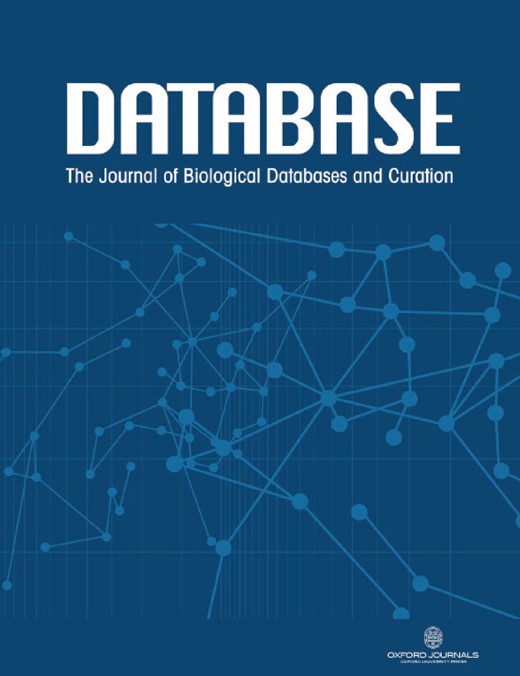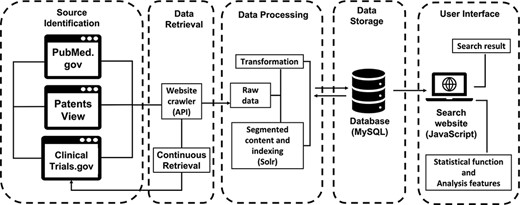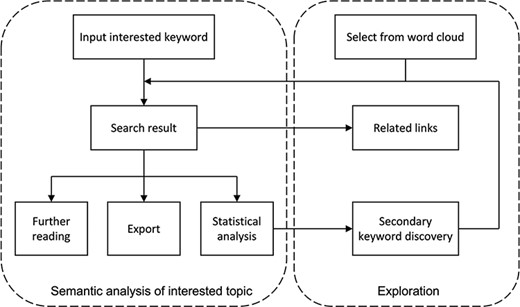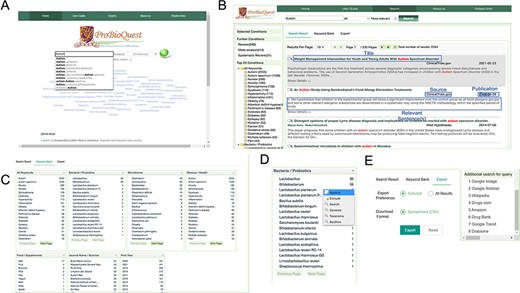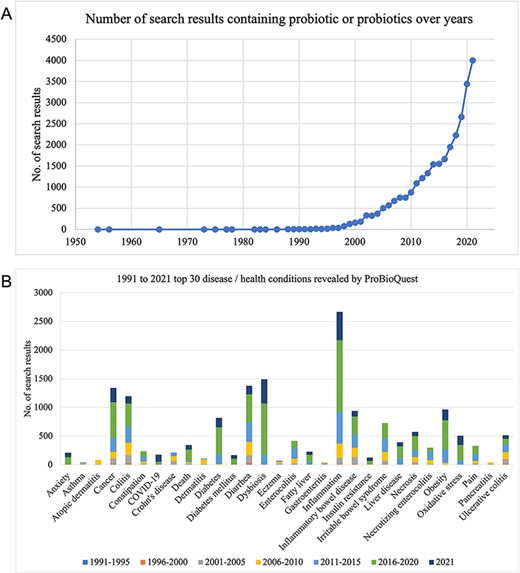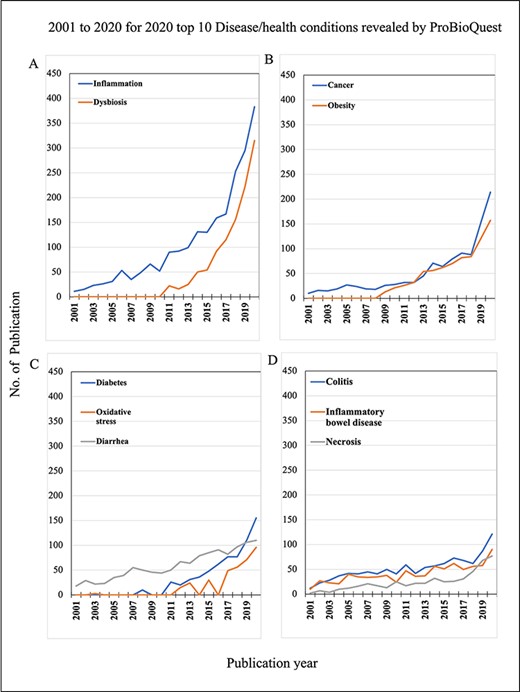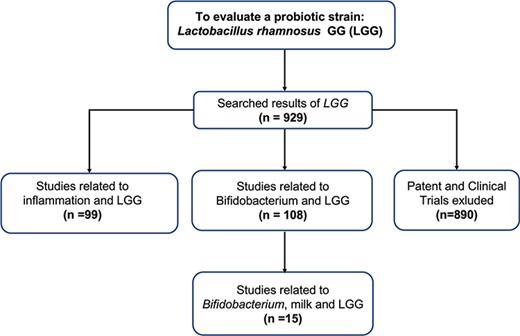-
PDF
- Split View
-
Views
-
Cite
Cite
Po Lam Chan, Susana Lauw, Ka Lee Ma, Nelson Kei, Ka Leong Ma, Yiu On Wong, Ho Yan Lam, Yee Yung Ting, Tsz Kwan Yau, Wenyan Nong, Dandan Huang, Yichun Xie, Peter Chi Keung Cheung, Hoi Shan Kwan, ProBioQuest: a database and semantic analysis engine for literature, clinical trials and patents related to probiotics, Database, Volume 2022, 2022, baac059, https://doi.org/10.1093/database/baac059
Close - Share Icon Share
Abstract
The use of probiotics to improve health via the modulation of gut microbiota has gained wide attention. The growing volume of investigations of probiotic microorganisms and commercialized probiotic products has created the need for a database to organize the health-promoting functions driven by probiotics reported in academic articles, clinical trials and patents. We constructed ProBioQuest to collect up-to-date literature related to probiotics from PubMed.gov, ClinicalTrials.gov and PatentsView. More than 2.8 million articles have been collected. Automated information technology-assisted procedures enabled us to collect the data continuously, providing the most up-to-date information. Statistical functions and semantic analyses are provided on the website as an advanced search engine, which contributes to the semantic tool of this database for information search and analyses. The semantic analytical output provides categorized search results and functions to enhance further analysis. A keyword bank is included which can display multiple tables of contents. Users can select keywords from different displayed categories to achieve easily filtered searches. Additional information on the searched items can be browsed via the link-out function. ProBioQuest is not only useful to scientists and health professionals but also to dietary supplement manufacturers and the general public. In this paper, the method we used to build this database-web system is described. Applications of ProBioQuest for several literature-based analyses of probiotics are included as examples of the various uses of this search engine. ProBioQuest can be accessed free of charge at http://kwanlab.bio.cuhk.edu.hk/PBQ/.
Introduction
The use of probiotics to improve health via the modulation of gut microbiota has gained wide attentions (1). Various health conditions such as obesity, type 2 diabetes, cancers, gastrointestinal disorders and depression might be alleviated through probiotic supplementation (2). At present, Lactobacillus and Bifidobacterium are the major lactic acid bacterial genera used in the probiotic supplements. The genus Lactobacillus has been reclassified into 25 genera, which include the L. delbrueckii group, Paralactobacillus and 23 novel genera (3). The growing volume of investigations of probiotic microorganisms and commercialized probiotic products has created the need for a database to compile the health-promoting functions driven by probiotics reported in the literature or clinical studies.
The workflow of ProbioQuest. The database works with continuous data retrieval from 3 public sources via API function. Our in-house Perl script transforms the raw data into the desired structure and then inputs it to MySQL. Subsequently, Solr creates segments of the content and indexes according to the title and abstract or summary of the processed data. The user interface was built by using JavaScript for searching, with its statistical function and analysis feature.
Online databases can be constructed to collect data and provide shortcuts, enabling users to access information of interest quickly and effectively (4). To date, several limited databases with the theme of probiotics have been developed. Previously, information on the functions of probiotics that were marketed or used in clinical, field and animal studies were provided in a probiotics database named PROBIO (5). Additionally, the functions of probiotics originating from fermented foods could be accessed using the probiotics database PBDB (6). Unfortunately, PROBIO and PBDB are no longer accessible. The probiotics databases AEProbio (http://usprobioticguide.com/) and Optibac Probiotics (http://www.optibacprobiotics.com/uk/professionals/probiotics-database) are currently accessible and can be used free-of-charge. Although their target users are health professionals, these databases are not updated frequently, and the scope for searching remains limited.
As the growing need for access to detailed information from different publications is not presently being consolidated, we have established a new database, ProBioQuest, to collect up-to-date articles related to probiotics from PubMed.gov, ClinicalTrials.gov and PatentsView. Automated information technology-assisted procedures have enabled us to parse the data continuously. Statistical functions are provided on the website, an advanced search engine, which contributes to the semantic tool of this database for information search and analyses. The output provides categorized search results and functions for further searching. ProBioQuest includes a keyword bank, which displays multiple tables of contents containing concepts of probiotics, microbiome, diseases and food. Users can select keywords from different displayed categories, enabling them to conduct a customized search. Additional information on the searched items can be browsed on Google Image, Google Scholar, Wikipedia, Drugs.com, Amazon, Drug Bank, Google Trend and Disbiome via the link-out function, giving ProBioQuest a superiority over existing knowledge-based search engines for probiotic studies. Therefore, ProBioQuest is a useful tool for scientists and health professionals, manufacturers of dietary supplements and the general public who are interested in probiotics. In this paper, the method we used to build this database-web system is described. We provide instructions for using the database.
Methodology
ProBioQuest is a database-web system with an advanced search engine designed for online intelligent searching of probiotics-related articles. Figure 1 shows the workflow of ProBioQuest. Targeted information from three public web resources was collected to create this database. With the aid of Application Programming Interface (API) technology (23), the database was developed by automated data collection using a Perl script, which enabled later data processing. The comprehensive keyword lists allowed the searching of in-depth probiotics-related resources. In the probiotics-related keywords bank generation process, the number of occurrences of each keyword was counted, with the incorporation of each article into the MySQL (24) database with statistical analysis. After data collection, Solr (25) was used for indexing and building a searchable probiotics database website, including back-end big data analytic applications. Keyword frequency was counted and displayed for easy visualization of relative popularity. A visual analytic, the ‘Keyword Cloud’, appeared on the front page. This provided a summary of the database by using the number of occurrences for each keyword to compute its corresponding size. For the user interface, we used JavaScript as the scripting language to build the website, exploiting its statistical functions for search results.
Source identification
ProBioQuest collects relevant information from various sources, including journal articles, patents and reports of clinical trials. The source websites we used were PubMed.gov (https://pubmed.ncbi.nlm.nih.gov/), PatentsView (https://www.patentsview.org/) and ClinicalTrials.gov (https://clinicaltrials.gov/). Our database extracted targeted information from these websites, which provide wide coverage of the corresponding type of resource. These three websites are generally considered to be reliable and professionally managed, and were therefore treated as sources of trustworthy information in our development of ProBioQuest.
The first website, PubMed.gov, contains more than 32 million abstracts and citations related to life sciences, biomedical science, chemical sciences, behavioral sciences and bioengineering. PubMed.gov includes articles that are in progress, not yet officially published, collected or not selected by the Medline database, published by National Institutes of Health (NIH) subsidized researchers and every document held by the National Library of Medicine (NLM) and the National Center for Biotechnology Information (NCBI). With the inclusion of the comprehensive academic literature database provided by PubMed.gov as a source, ProBioQuest can extract an extensive amount of information for exploitation by professional users in searching for academic articles.
Flow chart of semantic analysis and exploration on the user interface of ProBioQuest. Users can simply input the keyword of interest, and ProBioQuest will show related search results. Users can then click the results for further reading or export the selected result. To explore deep searching, ProBioQuest provides a statistical analysis of the search result and Keywords Bank allows further searching by adding a secondary keyword.
The second website, ClinicalTrials.gov, is a US government website maintained by the NLM at the NIH. It is updated daily and provides the most recent information about clinical research studies. This website contains information on over 403 000 clinical studies and research studies conducted around the world. It consists of a Protocol Registration and Results System (PRS), which is a web-based data entry system. Its public clinical results databases provide a route for extracting biomedical outcomes. Integrating ClinicalTrials.gov into our database enables health-care professionals to discover the latest probiotics-related investigations on the ProBioQuest website.
The third website, PatentsView, allows users to search patenting activities around the USA. Exploring data among 5 million US patents, 1.2 million inventors and 250 000 assignees data in 40 years, and extracting the disclosed patents in PatentsView allows ProBioQuest to include up-to-date probiotics-related patents. This makes for an efficient and easy patent search, enabling probiotics development experts to monitor market trends.
Data extraction, processing and storage
This database used the technique of API to extract all information from the source website databases for information completeness. We executed the scraping among sources of websites. Data records were searched and filtered out by keywords extracted. We used ‘Bacteria’, ‘Probiotic’, ‘Gut microbiome’, ‘Gut microbiota’, ‘Disease with gut’ and ‘Health with gut’ as search terms to retrieve the data. As we used Perl language to automate manual workflows, the computer performed the monotonous work of screening, filling and uploading. Rules and fields were set, then targeted information was extracted, including title, journal type (if from PubMed.gov), source, abstract or summary, authors or inventors or researchers, publication date and URL. Each extracted record was converted into columns and rows in the database by Perl script. Data flowed from the source websites to our ProBioQuest MySQL database. The collected data were stored in MySQL as a temporary database, integrating all the information required for the ProBioQuest database website.
After data extraction, the open-source software Solr was used to index the entries in the MySQL database. Abstract search and near real-time indexing were established by Solr. Indexing, a process of turning the original data into a highly efficient cross-reference lookup to facilitate rapid searching, is then performed. Solr does not index text directly, but rather breaks the text into individual tokens, then consults the search index. Matching results are retrieved, then sorted in the requested order (e.g. publication date). The purpose of storing an index is to optimize speed and performance in finding relevant documents for a search query. With an index, a search engine does not need to scan every document in the database, economizing on machine time and computing power.
Data extraction was maintained according to the keyword bank and included technical phrases of bacteria, probiotics, gut microbiome, gut-related disease and health. The design of the keyword bank was based on our previous database ‘Food Safety Information Database for Greater China’ (20). We collected terms and bacteria names from ‘NCBI Taxonomy’ (21) and ‘Clinical Guide to Probiotic Products Available in USA’ (22). ‘NCBI Taxonomy’ is a comprehensive update resource with a list of accurate organism names and classifications (21). Thus, we used ‘NCBI Taxonomy’ to find probiotic bacteria and microbiome related to gut, and further screened the bacteria name. The ‘Clinical Guide to Probiotic Products Available in USA’ provides a list of probiotics. We construed and separated the words and terms in this list into more specific categories. To provide the correlation with searched keywords, the frequency of these keywords was calculated.
Search procedure and advanced search function
The scalable and interactive functions of ProBioQuest were developed by JavaScript. One of the products was ProBioQuest’s keyword cloud (Figure 3A). Inside a keyword cloud, each keyword size is directly proportional to its frequency of occurrence. Showing keywords in different sizes can help users to choose which keywords to use. As JavaScript allows interaction between websites and users, clickable buttons can be made by coding. Users can tap the appropriate key on their keyboard to conduct searching instantly. ProBioQuest’s keyword bank is another useful function. Words in both the keyword bank page and sidebar (e.g. ‘add keyword’, ‘delete keyword’, ‘direct search’) enable searches to be refined. In ‘Bacteria/Probiotics’ and ‘Microbiome’ categories, keywords can be searched externally in BacDive (26) and NCBI for genome and taxonomy. These functions allow users to customize their search results and provide more accurate search results suited to the needs of different users. Finally, users can use the output function of the searched results and keywords. There is an export function that allows users to extract what they request as a spreadsheet (.csv) for their reference.
An overview of the user interface of ProBioQuest. (A) Home page includes a keyword cloud of the most frequent keywords from all seed articles, a search bar which offers suggestions while the user is typing and a help box for users unfamiliar with the system’s details. (B) Autism as an example of input and the search result. Each article is linked out to ClinicalTrials.gov, PubMed.gov or PatentsView with a simple click. (C) Novel feature in Keyword Bank tab. This tab shows relevant keywords in descending order of the number of articles they co-existed, which aids secondary key concept discovery of the interested topic. All keywords are divided into categories. (D) The secondary keyword can be appended into the search bar or linked out. (E) Search result can be exported as CSV format or linked out to search for additional information.
Besides offering keyword-related functions, ProBioQuest also allows users to link with external websites. Since only the abstracts of journal articles or clinical trials have been captured, users can click on the titles, which are linked to their original websites. Users can obtain full-text information from selected articles by this function without being overwhelmed with excessive information or overloading the database website. To complete more advanced searching, there is an additional information section on the sidebar. ProBioQuest integrates popular and useful search engines such as Google Image, Google Scholar, Wikipedia, Drugs.com, Amazon, Drug Bank, Google trend and Disbiome. By clicking the corresponding button on the sidebar, users can search the keyword on any or all of their websites, for a customized searching journey.
Results and discussion
Description of ProBioQuest, key features and applications
ProBioQuest was constructed as a database-semantic analysis engine platform with the link http://kwanlab.bio.cuhk.edu.hk/PBQ/. It is intended for researchers, healthcare professionals, probiotics developers and the general public to query and analyze probiotics information in relation to microbiome, health conditions and foods. This platform offers a scientific overview in the form of tables of contents of search terms and insights into relevant key concepts. Users can also explore by selecting from a keyword cloud displayed on the homepage. Further information about bacteria features, marketed probiotics, drugs and its public awareness over time are available by external links. A total of 2 894 703 articles were collected by the end of 2021: PubMed.gov: 2 656 818; Clinical Trials.gov: 205 349 and PatentsView: 32 536 (Table 1). ProBioQuest is set to continue retrievals and analyses of the literature daily and automatically.
Breakdown by source of entries in the ProbioQuest database (Data accessed on 31 December 2021)
| . | Number . |
|---|---|
| Total entries in the database | 2 894 703 |
| Entries from Pubmed.gov | 2 656 818 |
| Entries from PatentsView | 32 536 |
| Entries from ClinicalTrials.gov | 205 349 |
| . | Number . |
|---|---|
| Total entries in the database | 2 894 703 |
| Entries from Pubmed.gov | 2 656 818 |
| Entries from PatentsView | 32 536 |
| Entries from ClinicalTrials.gov | 205 349 |
Breakdown by source of entries in the ProbioQuest database (Data accessed on 31 December 2021)
| . | Number . |
|---|---|
| Total entries in the database | 2 894 703 |
| Entries from Pubmed.gov | 2 656 818 |
| Entries from PatentsView | 32 536 |
| Entries from ClinicalTrials.gov | 205 349 |
| . | Number . |
|---|---|
| Total entries in the database | 2 894 703 |
| Entries from Pubmed.gov | 2 656 818 |
| Entries from PatentsView | 32 536 |
| Entries from ClinicalTrials.gov | 205 349 |
On the homepage, users can select from a keyword cloud constructed from the most frequent keywords from articles. Alternatively, they may input the relevant keyword in the search bar. Suggestions based on our keyword bank will pop up while the user types. Each query, by default, searches from all sources in our database according to the title and abstract of sources and returns previews of articles, with the most relevant listed at the top in ‘Search Result’. In the preview, users can find a title, author names, relevant sentence(s), source and publication date. For clinical trials, users can click ‘Show Details’ for identifier, study type and location. Users who wish to read further are directed to an article by a simple click on its title.
In ‘Keyword Bank’, users can find the novel feature of ProBioQuset for keyword or key concept discovery on interesting topics. This tab shows the statistical analysis of relevant keywords and lists in descending order of the number of articles they co-existed. Keywords are divided into categories. These keywords can also be found in the scrollbar on the left of the screen. Secondary keywords can either be appended to the search, or excluded from it, or individually searched, by simply clicking ‘Append’, ‘Exclude’ and ‘Search’ respectively. Additionally, the keywords of ‘Bacteria/ Probiotics’ and ‘Microbiome’ can be linked to the NCBI Genome List, the NCBI taxonomy database or the database BacDive for further information of these entities by selecting ‘Genome’, ‘Taxonomy’ or ‘BacDive’ respectively. Additional external links (e.g. Google image) displayed at the end of the left scrollbar are directed to search results of the same keyword(s) used in ProBioQuest for easy access. Search results in ProBioQuest can be downloaded in the ‘Export’ tab. Figure 2 shows window-captured examples of semantic analysis and exploration on the user interface of ProBioQuest. Moreover, user guides are provided on the interface and a YouTube video (https://www.youtube.com/watch?v=PNiu7_uY_GM), has been created to demonstrate the key steps of searching in ProBioQuest.
ProBioQuest is not only an organized database but also a semantic tool to help users to search by disease, disorder and symptoms for the overall concept of the health or diseases condition, and potential probiotics to use. We demonstrated how to use this database through answering the questions ‘Are there any conditions commonly experienced by autism patients?’ and ‘Have any probiotics been tried to help autism?’ Users could search the word ‘autism’ and the result returns 2 294 articles (Figure 3A and B). Clicking the search result articles will lead to the sources. ‘Keyword Bank’ tab provides the overall concept that autism is commonly discussed with other conditions such as anxiety, schizophrenia, hyperactivity and dysbiosis in the ‘All Keywords’ category (Figure 3C). For users interested in finding probiotics beneficial to autism patients, the keyword category ‘Bacteria / Probiotics’ offers the relevant information quickly. The potential probiotics targets are rapidly narrowed to 10 species and 3 strains. The top species found is Lactobacillus plantarum. It can be linked out for its related taxonomy and strain information such as culture conditions (Figure 3D). By appending Lactobacillus plantarum to the search, a species strain and clinical trial of this particular strain is found. Its potential in relieving autism can be further evaluated. For further information in respect of the searched keywords, our database-website system directly links out to search for marketed probiotics products on the left scroll bar, or exports the search result as a CSV file (Figure 3E).
Evolving research interests of probiotics as revealed by ProBioQuest
We demonstrate here how the Keyword Bank feature in ProBioQuest can help users to gain information about the evolving research interests of probiotics. We entered the word ‘probiotic; probiotics’ into the search box, which displayed 28 561 articles in the ‘Search Results’ tab. In the ‘Keyword Bank’ tab, the number of articles in each year was shown in ‘Post Year’ in descending order of hits. The number of articles on probiotics has been growing rapidly (Figure 4A). The year can be appended into our search. We appended the year 2021 and clicked ‘Keyword Bank’. We collected all items and the corresponding frequency present on the first page of the ‘Disease/Health’ category under Keyword Bank. We conducted this data collection from 1991 to 2021. From the list of 498 items, 95 unique Disease/Health items were found. We obtained the top 30 items by ranking them in terms of their frequency from 1990 to 2021. The data were organized into groups of 5 years to show the changes in the numbers of returns (Figure 4B).
The number of articles containing ‘probiotic/probiotics’ from 1950 to 2021 and articles of top 30 Disease/Health in 5-years groups. (A) The number of articles on probiotics has been growing rapidly during the past two decades. (B) Popular topics such as inflammation, diarrhea and cancer maintained a high rate of occurrence in the articles from 1991 to 2021.
The top 10 most popular Disease/Health keywords in 2020 were selected for further analysis of these diseases/health items from 2001 to 2020 (Figure 5). Inflammation and dysbiosis have clearly grown in numbers. Specific diseases of awareness on metabolic disorders like obesity, diabetes and oxidative stress also increased in the past 10 years. Researchers seem to have shifted their interest from probiotics functions in gastrointestinal issues like colitis, inflammatory bowel disease, diarrhea and constipation to more physiological conditions. Almost all results on anxiety come from the past 5 years, indicating a rise in psychobiotics studies. We also found that researchers sometimes use more than one term for the same health condition. The number of articles on atopic dermatitis and eczema, for example, were counted separately, even though they are two terms describing the same skin issue. Unifying terms will benefit researchers in the future when reviewing published articles.
2001 to 2020 for 2020 top 10 Disease/Health conditions revealed by ProBioQuest. The top 10 most popular Disease/Health keywords in 2020 were selected for further analysis of their trends during the two decades from 2001 to 2020. (A) Inflammation and dysbiosis have clear trends of marked growth in numbers. (C–D) Specific diseases of awareness on metabolic disorders like obesity, diabetes and oxidative stress and diseases of abnormal cell growth like cancer and necrosis also increased in the past 10 years, although to a lesser extent.
Use of ProBioQuest to gather comprehensive and up-to-date information of a probiotic strain: Lactobacillus rhamnosus GG as example
As an example of how comprehensive and up-to-date information on the probiotic strain Lactobacillus rhamnosus GG (LGG) can be gathered, we used ProBioQuest to answer the following three questions: (i) What health conditions are associated with the probiotic strain Lactobacillus rhamnosus GG (LGG)? (ii) What probiotic bacteria are associated with LGG? (iii) What probiotic bacteria and foods are associated with LGG? The users could enter the word ‘Lactobacillus rhamnosus GG’ into the search box, which will display more than 900 items in the ‘Search Results’ tab of the data page. Variation of the item number and frequency statistics would be observed at different enquiry times owing to the continuous updating of ProBioQuest. To narrow down this vast amount of information to the more relevant subsets, users could click items on the ‘Keyword Bank’ section on the data page. It has the frequency ranking of all keywords, probiotics, microbiome, diseases, food, sources and post years. Inflammation (n = 99) is the most frequently mentioned health condition in the literature, and 2020 (n = 101) was the year when most of the research articles related to LGG were published. Bifidobacterium is an important member of the microbiome, which ranks first both in the ‘Bacteria / Probiotics’ category and in the ‘All Keywords’ statistics. Adding ‘Bifidobacterium’, by choosing the ‘Append’ option, will decrease the total number of results from 929 to 108 results in two clicks. To address the third question, users could return to the Keyword Bank to append ‘Milk’ under ‘Food / Supplements’, respectively. The total number of results related to Bifidobacterium, milk and LGG were narrowed down to 15, demonstrating the ease with which customized search for the information of a probiotic strain can be conducted using ProBioQuest (Figure 6).
Flowchart of using ProBioQuest to evaluate a probiotic strain-Lactobacillus rhamnosus GG. Searching Lactobacillus rhamnosus GG in ProbioQuest returned 929 results. There were 890 articles from Pudmed.gov. To narrow down the number of results to those of more specific interest, a second keyword (‘Bifidobacterium’ or ‘inflammation’) was added. This reduced the number of results to 108 and 99, respectively. The addition of more keywords would further reduce the number of results and narrow the field of enquiry.
Emerging application of probiotics revealed by ProBioQuest: autism spectrum disorder
High relevance of results is one of the key ways in which ProBioQuest can assist users in acquiring pertinent information efficiently. In recent years, probiotics have been proposed to play a role in treating autism spectrum disorder (ASD), not only to alleviate gastrointestinal dysfunction but also to reduce the severity of ASD. To investigate the therapeutic effect of probiotics on ASD, ProBioQuest, with data collected from a variety of reliable sources, can provide such information. When we used the keywords ‘probiotic’ or ‘probiotics’ and ‘autism’ with Database ‘All’ and Preference ‘Most relevant’ to search, the page of this entry displayed a total of 164 results, many were relevant to ASD and probiotics, from 2002 to 2021. That topic of studies gradually increased from 2018.
On the tab of ‘Keyword Bank’, ProBioQuest offers useful ideas relevant to the searched topic. Seven columns of keywords are offered for selection to further query targeted information about the associations between autism and probiotics, as well as sorted out diseases or specific probiotics that would help us to further study ASD and probiotics. In the Bacteria/ Probiotics column, there were two genera Lactobacillus and Bifidobacterium together with five species and three strains of probiotics used in studies that were mentioned in the abstract and have been studied for their influence on the severity of ASD. Lactobacillus rhamnosus GG provides a good example. A review article relating to the effects of probiotics on cognitive function in 2019 was retrieved (7). The review highlighted the findings of a randomized controlled trial on the potential effect of Lactobacillus rhamnosus GG in reducing the risk of ASD development, and concluded that probiotics might be a safe and effective therapy targeting ASD. Since there are a variety of proposed beneficial health effects of probiotics, their use should be further explored for their potential benefits and side effects.
Potential application of probiotics revealed by ProBioQuest: epilepsy
A search of PubMed.gov articles under ‘probiotic or probiotics’ and ‘epilepsy’ turned up only 20 results from 2015 to 2021, indicating that the study of probiotics related to epilepsy is a relatively new topic. One clinical study was recorded, and its related journal article was published in 2018 (8).
This database not only archives probiotics-related journal articles, clinical trials and patent records, but also records related to gut and gut microbiota. Searching ‘epilepsy’ and ‘gut’, turned up 92 items that mention epilepsy and gut. From the column of publication year, only a few reports on the relationship between epilepsy and gut before 2015 were returned. However, after 2018, journal articles on that topic doubled in number. The studies of gut have increased as more researchers pursue the understanding of the gut and its ecological potential (9). From the Keywords Bank, the ‘Microbiome’ category showed genera and species that have been studied, such as Prevotella, Bacteroides, Clostridium difficile and Entamoeba histolytica. These bacteria and their genomes can provide a starting point to find probiotic strains with potentials to reduce the frequency of seizures.
Significance of ProBioQuest to health sectors
Probiotics are commonly taken for the maintenance of health and well-being, alleviation of gastrointestinal discomforts and allergic conditions and during antibiotic therapy to replenish friendly bacteria (10). The probiotic market has been increasing recently (11). However, patients who are interested in probiotics have complained that it is difficult to find reliable information on the functions and mechanisms of action of probiotics (12). Although health professionals are expected to handle enquiries about probiotic use from patients and consumers, they too have indicated that they need to educate themselves more about probiotics (10, 13). Many health professionals let patients specify a particular probiotic strain for themselves (14), perhaps because they are not confident in their own knowledge in this area. ProBioQuest allows health professionals to search for information specific down to probiotic strains, it can help health professionals to be more confident in prescribing or recommending probiotics. Books, professional magazines and websites have been the key sources of information on probiotics acquired by health professionals (10), and keeping abreast of developments can be time-consuming. As ProBioQuest is an open, continuously updated system, users could explore up-to-date probiotic information with high relevance and credibility. Moreover, ProBioQuest can act as a learning platform to raise awareness and knowledge on probiotics among health professionals. By consulting the peer-reviewed academic papers in PubMed.gov, health professionals can obtain evidence-based knowledge that is appropriate to their clinical application. More importantly, the search results in ProBioQuest are categorized into probiotics, diseases, microbiome, food, original sources and post time. ProBioQuest will help busy health professionals to save time in mining information and acquire a knowledge of probiotics quickly and efficiently.
ProBioQuest can be used as a semantic tool for trends identification to discover the unexplored clinical applications and knowledge gaps concerning the mechanisms of actions of probiotics. Apart from gastrointestinal system, probiotics are used in the field of weight management, respiratory, immune, skin, nervous and cardiometabolic system (15). Although the health benefits of probiotics in research studies are increasingly reported, no probiotic has yet been approved by the US Food and Drug Administration for prevention or treatment of health problems (16). This is understandable because of the inconsistent data among studies and inadequate standardized protocols (17). Nevertheless, researches on probiotics and the microbiome are sponsored by the National Centre for Complementary and Integrative Health (19), highlighting the importance of disease management through modulation of gut microbiota. A literature review using the traditional search engines is time-consuming. ProBioQuest provides a quick and efficient way to obtain the necessary information. A broad spectrum of possibilities is offered from simple keywords to advanced searches. Besides limiting the set of relevant articles according to the key concepts, users could further improve the precision of information searching based on the types of database and articles according to their preferences. Additionally, they could export either selected or all search results, allowing them to build a collection of relevant information for an in-depth literature review.
Probiotics have aroused widespread general interest owing to their potential to improve health and alleviate disease (18). Over 2000 clinical trials and 300 systematic reviews on probiotics were included in the biomedical database Medline in July 2019 (16). It is noteworthy that some established probiotics could be used together with pharmaceutical agents, foods and lifestyles for health management (18). If manufacturers aim to launch a new probiotic product, they need to review journal articles and search probiotic strains supported by scientific evidence before product development. Safe probiotic strains possessing relevant functional properties should be selected by manufacturers. Therefore, ProBioQuest would serve as an important collection of up-to-date credible journal articles and clinical trials to assist manufacturers, especially those not familiar with scientific research in the field of probiotics, to evaluate and validate the beneficial effects of probiotics and formulate evidence-based probiotic products with clinical efficacy. By using ProBioQuest, manufacturers can not only explore the technologies of promoting probiotic survival along the gastrointestinal tract and manufacturing process but also the potential for their innovations to be patented.
Conclusion
Probiotics are used to supplement medical treatments in many diseases and health conditions. Interest in probiotics has increased tremendously in the past decade, and new articles, records of clinical trials and details of patents granted are published continuously. Despite this growing torrent of information, dedicated collections and analytical services have so far been lacking. The few available databases are either very small in scale or no longer accessible. We have constructed ProBioQuest, a database with probiotics as the central theme, with semantic analytical functions, external links and a user-friendly web-based interface. ProBioQuest is easy to use and captures up-to-date articles from PubMed, Clinical trials.org and PatentsView.org automatically. This tool meets the needs of probiotics information gathering and analysis for the probiotic scientific community, industry and health professionals. More than 2.8 million articles were collected by the end of 2021. Automated information technology-assisted procedures enable us to collect data continuously, providing the most up-to-date information. Statistical functions and semantic analyses are provided on the website as an advanced search engine, which makes this database a valuable semantic tool for information searches and analyses. Users can discover trends, discover hubs, identify popular, emerging and potential applications and make in-depth content analyses.
Acknowledgements
We would like to thank Probiolife limited, Ms Pui Chu Wong Shally and Sifa Wang for their support, and Dr David Wilmshurst for editing the English in this manuscript.
Funding
This work was partly supported by the Research Impact Fund (RGC Reference no.: R5034-18) provided by the Research Grants Council of HKSAR, PRC and by Wong & Chui Charitable Foundation Limited.
Conflict of interest
None declared.
References
Author notes
contributed equally to this work.


